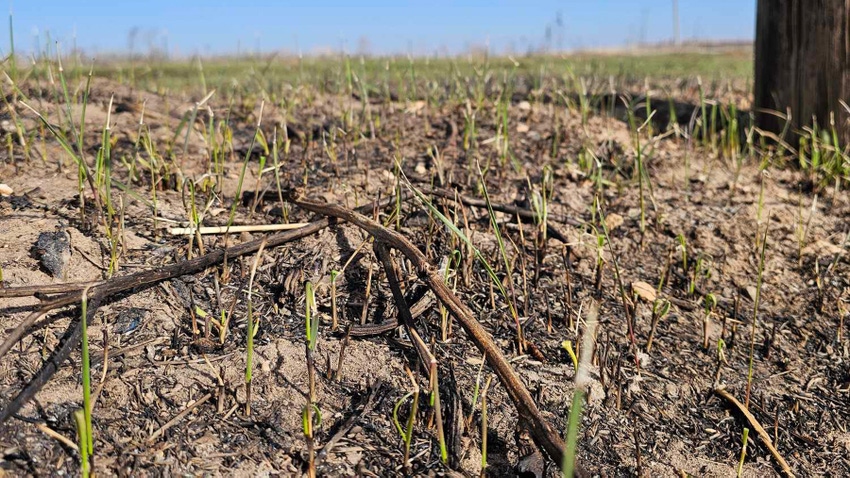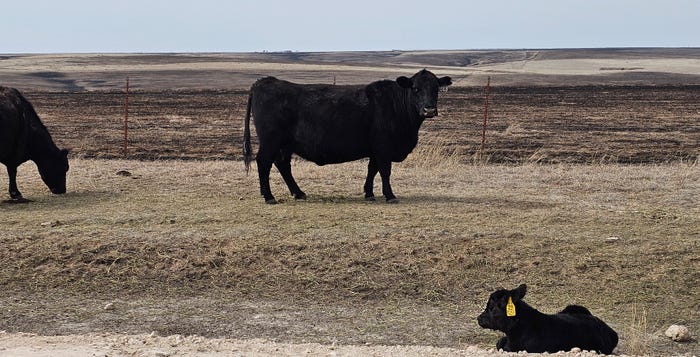
The immense Texas and Oklahoma Panhandle acreage burned in the late February wildfires is beginning to green up, but ranchers still have a gargantuan task ahead as they try to recover from the largest wildfire in Texas history.
The February 26 fire burned more than 1 million acres, leaving thousands of dead cattle, massive property damage, and two deaths. Andy Holloway, AgriLife Extension agent in Hemphill County, where pasture and cattle losses were significant, says rainfall a week ago helped regenerate grasslands, but more is needed.
“This county is diverse,” Holloway said. “South of the Canadian River, we have tighter soil than we do north of the Canadian, where it’s delicate sandhill land.

Burned pasture from the Smokehouse Creek Fire. (Shelley E. Huguley)
“That area has been blowing, and any kind of wind creates wind erosion. And if we get a hard rain, that will cause water erosion. All kinds of things can happen with those sandhills, so it takes them a lot longer to recover than it does in other parts of the county and region. Recovery depends on where you are. We still need a lot of rain, but we are greening up.”
Cows are grazing
Holloway says cows are no longer dependent on cake or hay. “They're getting enough green out in the pastures, and they're chasing that green. Ranchers are trying to figure out what's still sound grassland management in regard to their cow herds and grazing. They are also trying to make decisions about fencing.”
He said estimates put fencing losses at 2,500 miles. “That’s just exterior fencing that needs replaced or repaired. Ranchers lost cross-fencing as well. There's just so much to do, and they're just getting started.”
Holloway said financial aid is available.
Funds available
“Help is available, but it’s kind of like molasses; it’s slow, but it is coming. USDA has stepped up. They haven't started writing checks yet that I know of, but they are releasing information about programs that are available for fencing, dead cattle and potential payments for idling land. Programs are out there.”
He said funds from other organizations are also available. The Amarillo Area Foundation collected over $3 million and has distributed money to Hutchinson, Gray, Robertson, and Hemphill counties to these to help ranchers. That has been huge.
“Also, my local task force committee has received more than $1 million, and we've already pushed that out to help our ranchers. But so many need help. In my county, we have identified 183 ranches that were burned, some a lot worse than others.”
Holloway said every little bit helps, but dividing a million dollars among more than 100 ranchers means just a few thousand for each one.
“But if one gets $3,000, $4,000, $5,000 or $10,000, whatever one gets, it's like a breath of fresh air and some hope. It helps that guy know that somebody cares, and it helps him do what he needs to do.”
He said the Texas Department of Agriculture also has funds available. “Commissioner Sid Miller was here yesterday and announced that the Star Fund through the Texas Department of Agriculture has, I think he said $1,100,000 available for ranchers to apply for grants. The Texas and Southwestern Cattle Raisers organization has about $1.3 to $1.5 million that ranchers can apply for.
“Texas Farm Bureau is begging us to have people apply for help. I don't know how much they have available, but there is money out there.”
The one caveat, Holloway said, is the time necessary to fill out applications. “These ranchers have to fill out the paperwork when they're busy trying to keep their cows on their ranch and keep them fed and watered. They don't have a lot of time for some of the paperwork, but they're getting around to it.”
He said Extension has been trying to alert ranchers to the opportunities available for financial aid.
He’s a bit busy, himself.
“We're getting ready for the beef conference next Tuesday and Wednesday. We already have people from 26 U.S. states registered. I think we may have a record crowd. I think this is the most important beef cattle event of the year for Texas, maybe for the nation. I think that's why so many people have signed up.
“We also have a record trade show, 110 vendors, which throws our previous record out the door by a bunch.”
Support for ranchers continues in the Texas Panhandle as folks come to Canadian, Texas, for that conference. Those hard hit by the fire continue to rebuild fences, tend cattle, and plan for ways to move forward. Holloway reminds them that financial aid is available. “We are trying to get it pushed out to them as fast as we can.”
Holloway also noted that Mother Nature is doing her part. “If you came here today, you'd say it looked like a garden spot,” he said. “It has gotten that pretty again.”
But the soil, the grass, and the cattle need more. “We're supposed to have a chance for rain here on Saturday,” he said. "We really need it.”
About the Author(s)
You May Also Like






